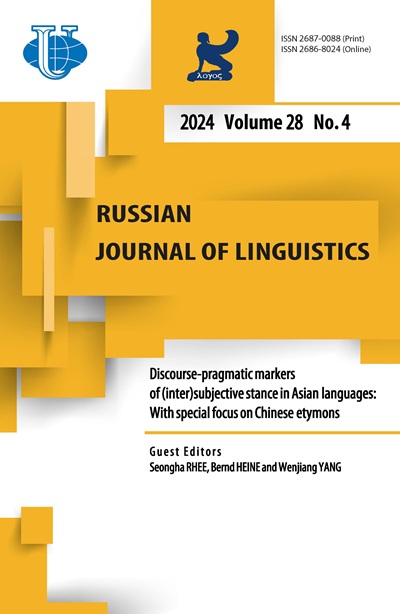От функции к системе: новая парадигма матричной структуры переводческого процесса
- Авторы: Ремхе И.Н.1, Нефедова Л.А.2, Гиллеспи Ч.Г.3
-
Учреждения:
- Магнитогорский государственный технический университет им. Г.И. Носова
- Челябинский государственный университет
- Университет г. Бат
- Выпуск: Том 20, № 3 (2016)
- Страницы: 230-242
- Раздел: Статьи
- URL: https://journals.rudn.ru/linguistics/article/view/14751
Цитировать
Полный текст
Аннотация
В статье представлено авторское видение переводческого процесса в рамках новой парадигмы развития когнитивного переводоведения на основе понятий синергии, кооперации, взаимодействия, взаимозависимости и когнитивных структур сознания переводчика. Представленная матричная модель перевода является результатом тщательного анализа возможностей, назревшей необходимости междисциплинарного подхода в переводоведении и поиска нового научно-теоретического основания для представления когнитивной сущности переводческого процесса. Матричная платформа, предложенная авторами исследования, выступает конгломератом фреймовых элементов, когнитивных функций и процедур, которые выстраиваются в виде трех ментальных пространств (нейрологического, репрезентационного и концептуального). При этом центральную роль занимает переводчик как мыслящий объект, способный оперировать познавательными структурами своего сознания. Практическая значимость модели верифицируется посредством психолингвистического эксперимента «Думай вслух». Результаты эксперимента представлены в виде уровней эффективности решаемых переводческих задач на основе ментальных пространств матричной модели перевода.
Ключевые слова
Об авторах
Ирина Николаевна Ремхе
Магнитогорский государственный технический университет им. Г.И. Носова
Email: rilix@mail.ru
455000, Россия, г. Магнитогорск, Проспект Ленина, д. 38
Лилия Амиряновна Нефедова
Челябинский государственный университет
Email: lan2@mail.ru
454001, Россия, г. Челябинск, ул. Бр. Кашириных, д. 129
Чарльз Гиллеспи Гиллеспи
Университет г. Бат
Email: d.c.gillespie@bath.ac.uk
ул. Клевертон Даун, г. Бат, район Норд Ист Сомерсет BA2 7AY, Великобритания
Список литературы
- Bernardini, S. (2001) Think-aloud protocols. Achievements. Limits. Future prospects, in Target 13:2, 241-263
- Berseneva T.P. (2013) Sinergiya i sinergetika: kategoriya isikhazma i sovremennaya nauka [Sinergy and Synergetics: Category of Isikhazm and Modern Science]. Vestnik Tomskogo Gosudarstvennogo Universiteta. Philosophiya. Sotsiologiya. Politologiya, no. 369, 41-47
- Buckminster, R.F. (1982) Synergetics. Explorations in the Geometry of Thinking. Macmillan Pub Co
- Byrne J. (2006) Technical Translation Usability Strategies for Translating Technical Documentation. Springer
- Chesterman, A. (1998). Communication strategies, learning strategies and translation strategies, in: Malmkjær, 135-143
- Connectionism (2015) Stanford Encyclopedia of Philosophy. Retrieved from: http://plato.stanford.edu/ entries/connectionism (accessed 10 January 2016)
- Cranmer, R. (2015). Introducing intercultural communication into the teaching of translation. Russian Journal of Linguistics. 19 (4), 155-173
- Dijk T.A. (1980). The semantics and pragmatics of functional coherence in discourse. In A. Ferrara (ed). Speech act theory: Ten years later. Milano, Italy: Versus, 49-65
- Downes, S. (2005) An Introduction to Connective Knowledge. Retrieved from: http://www.downes.ca/ post/33034 (Accessed: 09 January 2016)
- Farman, I.P. (2013). Construktivizm kak metod i sotsial’no-kul’turnaya praktika [Constructivism as method and socio-cultural practice]. In V.A. Lektorsky (ed.). Konstruktivizm v teorii poznaniya [Constructivizm in the theory of knowledge] (pp. 88-116), Rossiiskaya akademiya nauk. Institut Filosofii, Moskva: IFRAN (In Russian)
- Fauconnier, G. (1998). Mental spaces, language modalities, and conceptual integration. In M. Tomasello (ed.). The New Psychology of Language (pp. 251-279). Mahwah, NJ: Lawrence Erlbaum. Available at: http://citeseerx.ist.psu.edu/viewdoc/download?doi=10.1.1.99.9811&rep=rep1&type=pdf (accessed 21 June 2016)
- Gerloff, P. (1986). Second language learners’ reports on the interpretive process: Talk aloud protocols of translation, in: House and Blum-Kulka, 243-262
- Jääskeläinen, R. (1993). Investigating translation strategies. In S. Tirkkonen-Conditand, J. Laffling (ed.). Recent trends in empirical translation research. Joensuu: University of Joensuu Faculty of Arts, pp. 99-120
- Koskinen, K. (2015) Training translators for a superdiverse world. Translators’ intercultural competence and translation as affective work, Russian Journal of Linguistics, 19(4), 175-183
- Krings, H.P. (1986). Translation problems and translation strategies of advanced German learners of French (L2). House and Blum-Kulka, pp. 263-275
- Kushnina L.V. (2005) Vzaimodeistviye yazykov i kul’tur v perevodcheskom prostranstve: geshtal’t-sinergetichesky podkhod [Interrelation between Languages and Culture. Applying the Theory of Gestalt and Synergy] (PhD Thesis), Moskva, RGB (In Russian)
- Kushnina L.V., Geikhman L.K., Neganova A.O., (2015). Mezhyazykovaya i mezhkul’turnaya variativnost’ pri perevode tekhnicheskikh tekstov: sinergetichesky podkhod [Interlingua and Intercultural Variation in the technical Translation: Synergetic Approach]. Sovremennye problem nauki i obrazovaniya, no. 1-1. Retrieved from: http://www.science-education.ru/ru/article/view?id=19556 (accessed 10 February 2016)
- Lave, J. (1988). Cognition in Practice: Mind, mathematics, and culture in everyday life. Cambridge, UK: Cambridge University Press
- Lörscher, W. (1991). Translation performance, translation process, and translation strategies: A psycholinguistic investigation. Tübingen: Gunter Narr
- Mondahl, M, Knud A.J. (1996). Lexical search strategies in translation, Meta 41:1, 97-112
- Nefedova L.A., Remkhe I.N. (2014). Towards cognitive modelling of the technical translation process. Proceedings of the XXV Annual International Academic Conference Language and Culture, 20-22 October 2014. Procedia - Social and Behavioral Sciences, no. 154, Elsevier, 237-245
- Padilla, P., Bajo, M.T., Padilla, F. (1999) Proposal for a cognitive theory of translation and interpreting: A methodology for future empirical research, in: The Interpreters' Newsletter, no. 9 (ed. EUT), Edizioni Università di Trieste Citazione, 61-78. Retrieved from: http://hdl.handle.net/10077/2213 (accessed 25 June 2016)
- Piaget, J. (1990). The child's conception of the world. New York: Littlefield Adams
- Rosch, E. (2016, June 20). Principles of Categorization. In: Cognition and categorization (eds. E. Rosch, B. Lloyd), University of California Press, 27-48. Retrieved from: http://commonweb.unifr.ch/ artsdean/pub/gestens/f/as/files/4610/9778_083247.pdf
- Séguinot, C. (1996). Some thoughts about think-aloud protocols, in: Target 8:1, 75-95

















